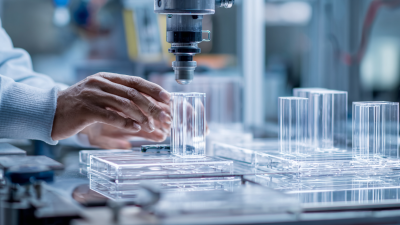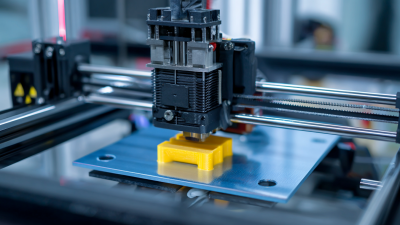
In today’s fast-paced manufacturing landscape, the demand for efficiency and precision has never been greater, making the effective utilization of rapid sheet metal a crucial component of production strategies. According to a report by MarketsandMarkets, the sheet metal fabrication market is expected to reach USD 276.8 billion by 2026, driven by the growing requirements for lightweight materials and complex geometries in various industries.
 Rapid sheet metal processes, which allow for quick prototyping and reduced lead times, have emerged as a game-changer for manufacturers seeking to streamline their operations and improve product quality. By leveraging advanced technologies such as laser cutting, CNC machining, and 3D printing, companies can achieve enhanced design flexibility and faster market delivery. This article will explore the best practices for utilizing rapid sheet metal in your manufacturing projects, empowering organizations to stay competitive and innovate effectively in a demanding environment.
Rapid sheet metal processes, which allow for quick prototyping and reduced lead times, have emerged as a game-changer for manufacturers seeking to streamline their operations and improve product quality. By leveraging advanced technologies such as laser cutting, CNC machining, and 3D printing, companies can achieve enhanced design flexibility and faster market delivery. This article will explore the best practices for utilizing rapid sheet metal in your manufacturing projects, empowering organizations to stay competitive and innovate effectively in a demanding environment.
Rapid sheet metal manufacturing has revolutionized the way industries approach design and production. One of the major advantages is the speed of fabrication, allowing for faster prototyping and reduced time-to-market. According to a report by SME, manufacturers using rapid sheet metal processes can see lead times reduced by up to 75%. This efficiency not only accelerates project timelines but also enhances a company’s ability to respond to market demand quickly.
Additionally, rapid sheet metal techniques often lead to cost savings. A study from Frost & Sullivan highlights that companies can reduce production costs by as much as 30% when switching to advanced sheet metal manufacturing technologies. These savings are largely attributed to reduced material waste and the elimination of expensive traditional tooling. By implementing rapid sheet metal, manufacturers can maintain high quality while optimizing their budget.
**Tips:**
1. Always evaluate your design for manufacturability to maximize the advantages of rapid sheet metal processes.
2. Consider using advanced software tools for modeling and simulation to identify potential issues before production begins.
3. Maintain open communication with your supplier to ensure the best practices are being followed throughout the manufacturing process.
| Advantage | Description | Impact on Manufacturing | Application Example |
|---|---|---|---|
| Speed | Rapid prototyping allows for quick turnaround times from design to final part. | Faster production cycles and reduced time-to-market. | Creating prototypes for automotive components. |
| Flexibility | Ability to adapt designs quickly based on customer feedback. | Efficiently integrates design changes without lengthy lead times. | Customizing products based on user input. |
| Cost-effectiveness | Lower costs for low to medium volume production runs. | Reduction in overall manufacturing expenses. | Small batch manufacturing of electronic housings. |
| Precision | High accuracy in the production of complex geometries. | Enhances quality and functionality of the final product. | Manufacturing precision parts for medical devices. |
| Material Variety | Wide range of materials available, including metals and plastics. | Provides options to meet specific project requirements. | Choosing materials for constructing housing units. |
When selecting materials for sheet metal projects, several key considerations come into play. One of the most critical factors is the material's mechanical properties, including tensile strength, ductility, and hardness. According to a report by the Fabricators & Manufacturers Association, materials like aluminized steel and galvanized steel are preferred due to their excellent strength-to-weight ratios and corrosion resistance. Additionally, stainless steel remains a top choice in industries requiring durability and aesthetic appeal, boasting a tensile strength of about 520 MPa, which is significant for various applications.
Another vital consideration is the manufacturing process compatibility with the chosen material. For example, while aluminum has lower density and is easier to work with, which can lead to cost savings, it may not be suitable for applications requiring high strength. The Precision Metalforming Association highlights that the choice between laser cutting and traditional stamping techniques can significantly impact material selection. Ultimately, understanding these nuances not only ensures optimal performance in manufacturing projects but also enhances the efficiency of production and reduces waste, aligning with the industry's push for sustainability.

Rapid prototyping with sheet metal has become an essential component in modern manufacturing, allowing companies to bring their products to market faster while maintaining quality. According to a report by Grand View Research, the global rapid prototyping market is expected to reach $35.6 billion by 2027, driven by the demand for faster product development and customization capabilities. To streamline the rapid prototyping process with sheet metal, manufacturers can follow a few key steps.
First, employing advanced CAD software is crucial for creating precise designs that can be easily translated into sheet metal parts. This software allows for iterative prototyping, enabling engineers to quickly test and modify designs before final production. A study from TechNavio indicates that companies using CAD tools can reduce time-to-market for new products by up to 30%. Next, integrating smart machinery such as laser cutting and CNC machines can enhance efficiency and accuracy in producing sheet metal prototypes. This technology not only reduces manufacturing time but also minimizes material waste, which is critical given that the sheet metal industry has reported a waste reduction of over 20% with these advanced techniques.
Finally, adopting a collaborative approach with suppliers can expedite the prototyping process. By leveraging supplier expertise in material selection and fabrication processes, manufacturers can gain insights that help eliminate bottlenecks in production. As reported by Deloitte, companies that engage in collaborative supplier relationships can achieve up to 25% faster cycle times and improve overall product quality. By focusing on these steps, organizations can effectively harness rapid sheet metal prototyping to meet the demands of an increasingly competitive marketplace.
This chart illustrates the effectiveness of rapid sheet metal utilization in different aspects of the manufacturing process. Higher impact levels indicate greater benefits in areas such as design iteration and production time, which are critical for streamlining the rapid prototyping process.
When designing for manufacturability in sheet metal projects, understanding the nuances of the material and the manufacturing process is essential. According to a report by SME (Society of Manufacturing Engineers), improper design decisions can lead to production delays and increased costs, often reducing profit margins by up to 20%. Therefore, leveraging best practices is crucial for optimizing the use of rapid sheet metal.
To start, consider the geometry of your design. Simple shapes are easier and less costly to manufacture. Avoid intricate details that require additional tools or processing techniques, as this can significantly inflate your budget. As per the Fabricators and Manufacturers Association, focusing on utilizing standard shapes and sizes can reduce lead times by approximately 30%, streamlining the production process.
**Tips:** Ensure your tolerances are realistically reviewed; overly tight tolerances can complicate the manufacturing process. Additionally, focusing on design features that promote easy assembly will not only facilitate efficient manufacturing but also enhance product durability. Incorporating design for assembly principles can lead to a reduction in labor costs by as much as 15%, making your project both cost-effective and efficient.

Integrating rapid sheet metal solutions into your production workflow can significantly enhance efficiency and reduce lead times. By adopting advanced technologies such as laser cutting and CNC machining, manufacturers can produce high-quality metal components faster and with greater precision. This integration allows for streamlined processes, minimizing the time between design and production. Furthermore, the flexibility of rapid sheet metal fabrication enables quick adjustments to designs, accommodating last-minute changes or unique customer demands without incurring significant delays.
To maximize the benefits of rapid sheet metal, it is essential to collaborate closely with fabrication partners who understand your manufacturing goals. Early involvement of these partners can facilitate better design choices that leverage the capabilities of rapid sheet metal. Additionally, implementing CAD/CAM software can increase automation, further optimizing the production workflow. By establishing clear communication channels and ensuring that all stakeholders are aligned, manufacturers can seamlessly incorporate rapid sheet metal solutions into their operations, leading to improved product turnaround times and enhanced overall productivity.







| Cookie | Duration | Description |
|---|---|---|
| cookielawinfo-checkbox-analytics | 11 months | This cookie is set by GDPR Cookie Consent plugin. The cookie is used to store the user consent for the cookies in the category "Analytics". |
| cookielawinfo-checkbox-functional | 11 months | The cookie is set by GDPR cookie consent to record the user consent for the cookies in the category "Functional". |
| cookielawinfo-checkbox-necessary | 11 months | This cookie is set by GDPR Cookie Consent plugin. The cookies is used to store the user consent for the cookies in the category "Necessary". |
| cookielawinfo-checkbox-others | 11 months | This cookie is set by GDPR Cookie Consent plugin. The cookie is used to store the user consent for the cookies in the category "Other. |
| cookielawinfo-checkbox-performance | 11 months | This cookie is set by GDPR Cookie Consent plugin. The cookie is used to store the user consent for the cookies in the category "Performance". |
| viewed_cookie_policy | 11 months | The cookie is set by the GDPR Cookie Consent plugin and is used to store whether or not user has consented to the use of cookies. It does not store any personal data. |

